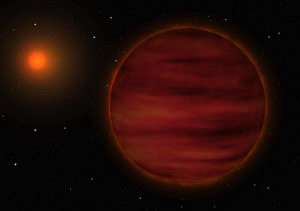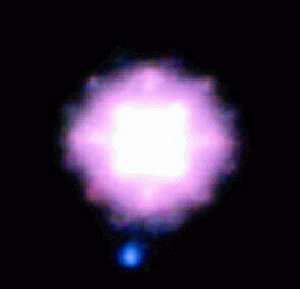The Sun's New Exotic Neighbour

Using ESO's Very Large Telescope in Chile, an international team of researchers discovered a brown dwarf belonging to the 24th closest stellar system to the Sun. Brown dwarfs are intermediate objects that are neither stars nor planets. This object is the third closest brown dwarf to the Earth yet discovered, and one of the coolest, having a temperature of about 750 degrees Centigrade. It orbits a very small star at about 4.5 times the mean distance between the Earth and the Sun. Its mass is estimated to be somewhere between 9 and 65 times the mass of Jupiter.
At a time when astronomers are peering into the most distant Universe, looking at objects as far as 13 billion light-years away, one may think that our close neighbourhood would be very well known. Not so. Astronomers still find new star-like objects in our immediate vicinity. Using Eso's VLT, they just discovered a brown dwarf companion to the red star SCR 1845-6357, the 36th closest star to the Sun.
"This newly found brown dwarf is a valuable object because its distance is well known, allowing us to determine with precision its intrinsic brightness", said team member Markus Kasper (ESO). "Moreover, from its orbital motion, we should be able in a few years to estimate its mass. These properties are vital for understanding the nature of brown dwarfs."

To discover this brown dwarf, the team used the high-contrast adaptive optics NACO Simultaneous Differential Imager (SDI) on Eso's Very Large Telescope, an instrument specifically developed to search for extrasolar planets. The SDI camera enhances the ability of the VLT and its adaptive optics system to detect faint companions that would normally be lost in the glare of the primary star. In particular, the SDI camera provides additional, often very useful spectral information which can be used to determine a rough temperature for the object without follow-up observations.
Located 12.7 light-years away from us, the newly found object is nevertheless not the closest brown dwarf. This honour goes indeed to the two brown dwarfs surrounding the star Epsilon Indi, located 11.8 light years away.
However, this newly discovered brown dwarf is unique in many aspects. "Besides being extremely close to Earth, this object is a T dwarf - a very cool brown dwarf - and the only such object found as a companion to a low-mass star," said Beth Biller, a graduate student at the University of Arizona and lead author of the paper reporting the discovery. "It is also likely the brightest known object of its temperature because it is so close."
The discovery of this brown dwarf hints that, at least close to the Sun, cool brown dwarfs prefer to be part of a couple with a star or another brown dwarf, rather than wandering alone in the cosmic emptiness. Indeed, of the seven cool brown dwarfs that reside within 20 light years of the Sun, five have a companion.
"This has wide-ranging implications for theories of brown dwarf formation, which, until now, tend to favour the production of single brown dwarfs," said team member Laird Close (University of Arizona).
The work presented here will appear as a Letter to the Editor in the Astrophysical Journal ("Discovery of a Very Nearby Brown Dwarf to the Sun: A Methane Rich Brown Dwarf Companion to the Low Mass Star SCR 1845-6357", by B. Biller et al.).
Source: European Southern Observatory (ESO)


















